- Created by Chellie Esters , last modified by Anastasiya Dashuk (Unlicensed) on Jun 17, 2020
You are viewing an old version of this content. View the current version.
Compare with Current View Version History
« Previous Version 52 Next »
Proposals specify labor, material, travel, freight, and other charges for a potential service. You can submit proposals to your clients to bid on work, increase the NTE, or change the scope of work for an existing work order.
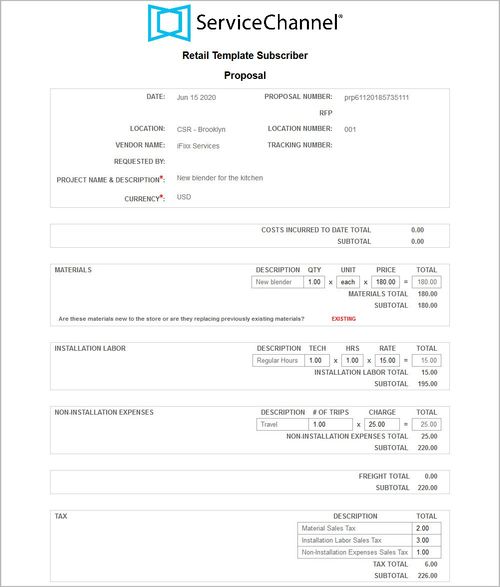
You can create and submit proposals in the Proposals and RFPs module in Provider Automation. You can create:
- A standalone proposal to request a higher NTE amount or submit a request for work needed at a location
- Proposal linked to a work order to increase the scope of work for an existing WO
- Proposal submitted through an RFP to bid on client’s projects
After you submit a proposal, your client reviews it, if satisfied with your offer, approves the proposal.
Creating a Standalone Proposal
Creating a standalone proposal is useful when your client requires you to submit one to raise the NTE or to upgrade equipment or wiring. In Provider Automation, you do not need a request for proposal (RFP) from a client to create a standalone proposal.
For proposals created in response to a client's request, see Creating a Proposal for an RFP.
For proposals stemming from a work order, see Creating Proposals Linked to a Work Order.
- On the top navigation bar, click Proposals. The proposals and RFPs page appears.
- Under the Proposals column, click Create Proposal. The page for searching for a location appears.
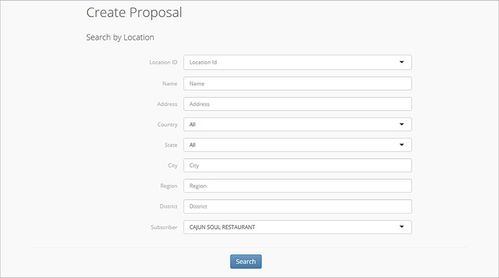
- Use the filters on the page to find the location for which you want to submit a proposal, and then click Search. The page with locations that match your search criteria appears.
Click the desired location, select the appropriate trade from the drop-down list, and then click Next. The page with location details opens.
Important
Should you need to create a proposal due to an increased scope of work on an existing work order, stop and follow the steps for Creating a Proposal Linked to a Work Order.
- Review the location details to make sure that you’re submitting a proposal for the right location, and then click Next. The page for creating a proposal appears.
To the right of the proposal form you may find instructions on how to fill it out. These guidelines are provided by your client to help you understand the requirements for expected proposal details. Follow these rules when completing the form to increase the likelihood that your proposal will be approved.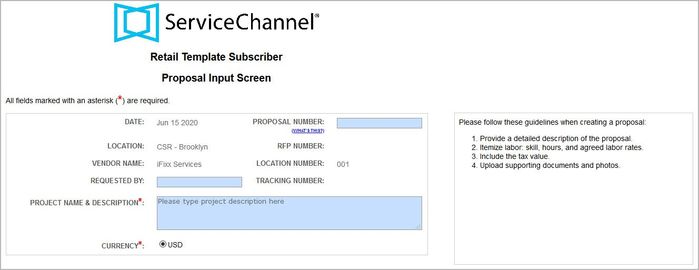
Enter a brief Project Name and Description. The Proposal Number populates automatically after you submit a proposal.
If Auto-generated appears in the proposal number input field, you cannot enter your own proposal number. However, if the field is empty, you can provide your own number.
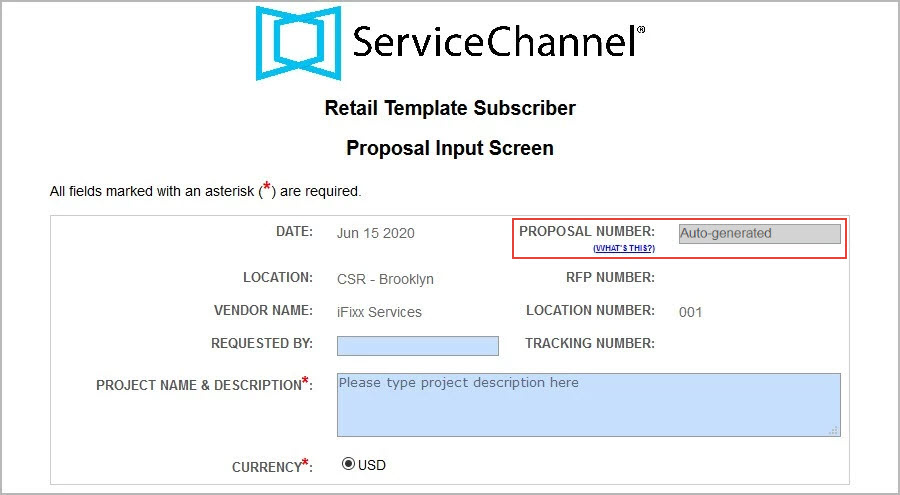
Proceed through the remaining sections by filling out the fields highlighted in blue. Once you enter the info for a line item, click the blue arrow at the bottom of the screen to proceed to the next line item.
Note that the proposal total and line item subtotals are calculated automatically, so you don’t have to enter them. Also, you can add additional rows for each line item as required.
- Costs incurred to date. Enter a description and a total into the appropriate fields.
- Materials. Enter a description, quantity, unit, and price for each material. Also, do not forget to indicate whether the materials are new or replacing the existing materials.
Installation labor. Enter the number of technicians, hours, and rates.
To provide the total labor charge instead of itemizing numerous labor charges, use the Flat Fee Labor field.
- Non-installation expenses. Enter a number of trips made and charges. Also, enter additional and non-installation fees.
- Freight. Enter the total freight charges.
- Tax. Enter the total tax charges for each line item.
- Attachments. Attach up to five files to the proposal that you’re creating.
Once all sections are complete, the proposal breakdown appears. It shows the proposal line items, their subtotals, and the proposal grand total.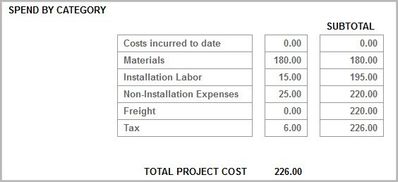
- Click Preview Proposal to begin submitting your proposal.
Review the information you’ve entered and select the I Confirm the Data on the Form is Correct checkbox. If the proposal contains sections where you have a zero (0.00) total charge, a second checkbox should be present. Select this checkbox to confirm that it is correct that the sections listed have a total charge of zero (0.00).
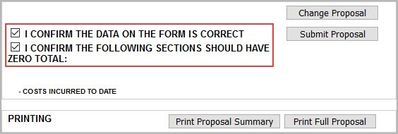
Should you need to edit your proposal, click Change Proposal and make the required modifications. Note that proposals cannot be modified once submitted.
- Click Submit Proposal. The proposal is now entered into the system and sent to the client.
After a few seconds, the proposal you’ve just submitted shows up on the Proposals list. Click View Proposal to check the proposal details.
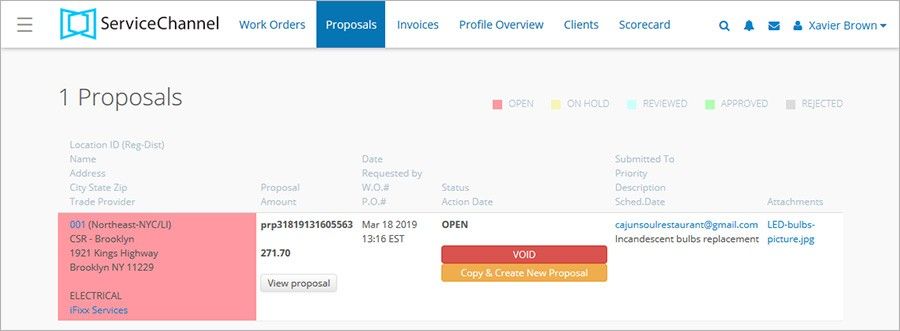
If a revised proposal needs to be submitted, it must be for the original proposal amount plus/minus the difference. If two proposals are approved, the NTE is updated to the grand total of the proposal that was approved last. The NTE amount is not updated to the total of both approved proposals.
Creating a Proposal Linked to a Work Order
You can submit a proposal linked to work orders for issues such as fixing problems found while performing routine maintenance or to increase the scope of work for an existing work order.
- On the top navigation bar, click Work Orders. The WOs list appears.
- Using the filters on the left, find a work order for which you need to create a proposal.
- Click Create Proposal on the required work order.

Review the work order info, and click Next. The page for creating a proposal opens. The work order Tracking Number and the WO Description automatically appear on the proposal form.
The work order problem description is displayed both on the proposal form and on the proposals list. If the description is modified on the work order, it’s also updated on the proposal.
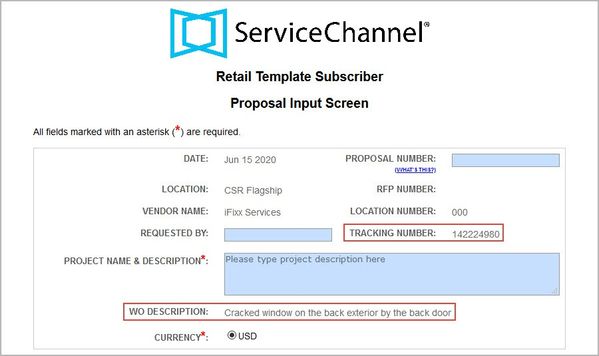
- Follow steps 6–10 for Creating a Standalone Proposal.
After you submit the proposal, it is displayed on the Proposals list. Click View Proposal to check the proposal details or follow the WO# or PO# link to view the work order information.

Creating a Proposal for an RFP
You can also create a proposal for an existing request for proposal (RFP) to bid on your client’s projects.
- On the top navigation bar, click Proposals. The proposals and RFPs page appears.
- Under the RFPs column, click View/Process RFP. The page for searching and filtering RFPs appears.
- Use the filters on the page to find RFPs submitted to you by your clients. You can search by RFP number, work order or purchase order number, RFP status, and more.
- Click Retrieve Report to view the list of RFPs that match your search criteria.
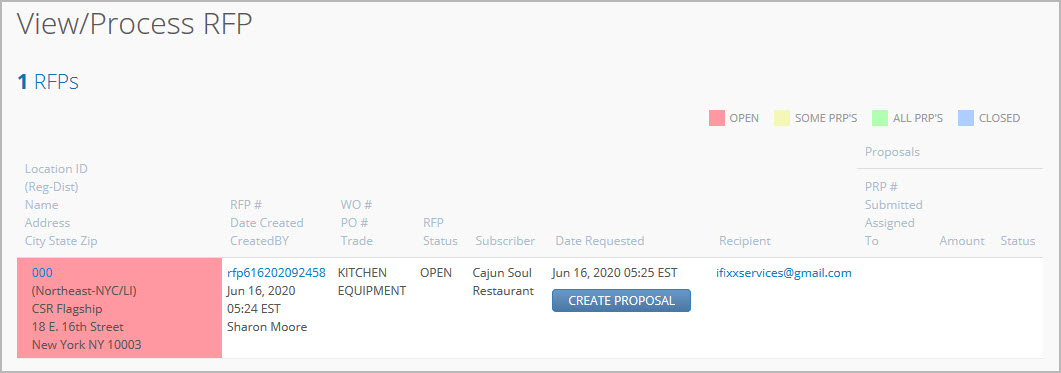
- Click Create Proposal on the RFP you wish to respond to. The page for reviewing location details appears.
- Review the location details and click Next. The page for creating a proposal appears. Note that the RFP number is present in the RFP Number field.
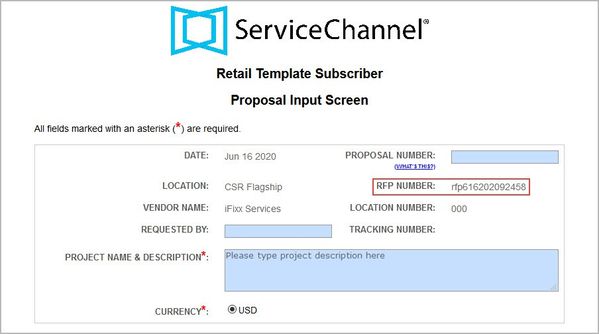
- Follow steps 6–10 for Creating a Standalone Proposal.
After you submit the proposal, it is displayed on the Proposals page. Click View Proposal to check the proposal details.
- No labels

